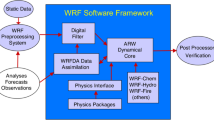Abstract
Due to the high costs of accessing massively parallel and vector environments, as well as the overworking of high-performance computers, there is now a need for a different approach to parallel computing. The feasibility of ocean modeling in a moderately parallel environment is tested using a 2-D (vertically-integrated) ocean circulation model. The parallel algorithm is based on the Glenda message-passing software and follows the master-worker paradigm. It is evaluated on both internal and external communication environments. The numerical experiments show that the internal communication environment is only slightly more efficient than the external communication environment. This is due to a combination of shared memory problems in the internal communication environment and to inefficiencies in the message-passing software. The tests also demonstrate how efficiency depends on the domain sub-divisions. Most importantly, they show that both environments effectively outperform their sequential counterparts, reducing the program elapsed time, and offering quicker access to the model outputs. The parallel version provided a time-saving alternative to the sequential version of the same model on both internal and external communication platforms. This research supports the conclusion that both environments are a viable alternative to single-CPU machines and that moderately parallel environments are feasible computer platforms for ocean modeling applications.
Similar content being viewed by others
REFERENCES
Bickham, J. L. (1995). Parallel ocean modeling using Glenda, Master's Thesis, University of Southern Mississippi, Hattiesburg, Mississippi.
Bleck, R., Dean, S., O'Keefe, M., and Sawdey, A. (1995). A comparison of data-parallel and message passing versions of the Miami isopycnic coordinate ocean model, Parallel Computing 21, 1695-1720.
Carriero, N., and Gelernter, D. (1991). How to Write Parallel Programs. A First Course, MIT Press, Cambridge, Massachusetts.
Chassignet, E. P., and Gent, P. R. (1991). The influence of boundary conditions on mid latitude jet separation in ocean numerical models, J. Phys. Oceanography 21, 1290-1299.
Geist, A., Beguelin, A., Dongarra, J., Weicheng, J., Mancheck, R., and Sunderam, V. (1994). PVM: Parallel Virtual Machine—A Users' Guide and Tutorial for Networked Parallel Computing, MIT Press, Cambridge, Massachusetts.
Gomez-Valdes, J., and Wang, D.-P. (1995). Massively parallel processing in coastal ocean circulation model, J. Sci. Computing 10, 305-323.
Hedstrom, K. S. (1994). User's Manual for a Semi-Spectral Primitive Equation Ocean Circulation Model, Institute of Marine and Coastal Sciences, Rutgers University.
Pedlosky, J. (1979). Geophysical Fluid Dynamics, Springer-Verlag, New York, p. 624.
Seyfarth, B. R., Bickham, J. L., and Peggion, G. (1995). Glenda Software Design, COAM Technical Report, University of Southern Mississippi Center for Ocean and Atmospheric Modeling.
Woodward, P. R. (1996). A Perspective on Supercomputing: Three Decades of Change, University of Minnesota Laboratory for Computational Science and Engineering.
Author information
Authors and Affiliations
Rights and permissions
About this article
Cite this article
Bickham, J.L., Peggion, G. & Seyfarth, B.R. Testing Moderately Parallel Environments for an Ocean Modeling Application. Journal of Scientific Computing 13, 185–200 (1998). https://doi.org/10.1023/A:1023274127822
Issue Date:
DOI: https://doi.org/10.1023/A:1023274127822




